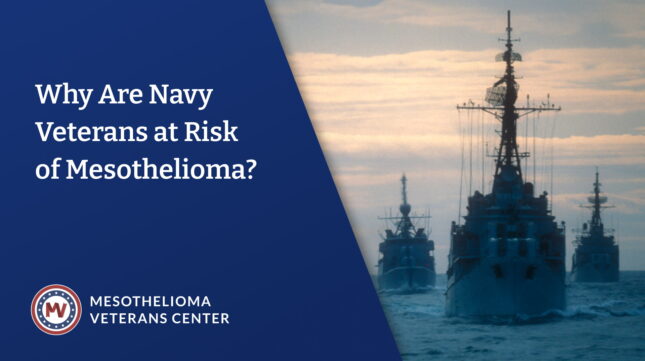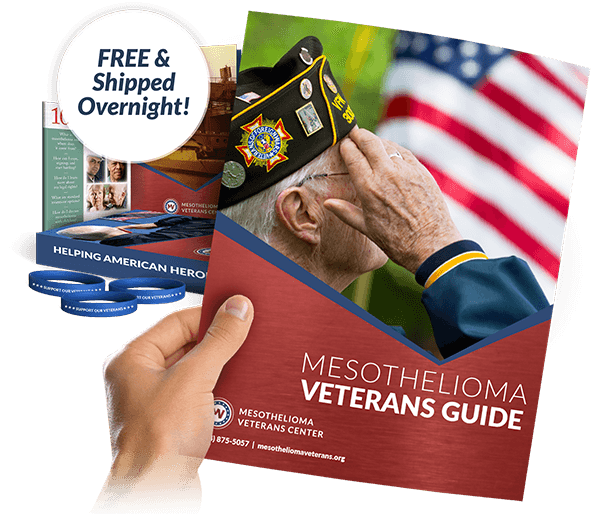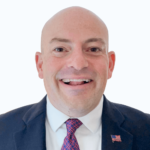Asbestos, a cancer-causing material, was used in nearly all U.S. Navy ships built before the early 1980s. Every sailor or worker who served on these ships may be at risk of mesothelioma, a cancer caused by asbestos, today. Thankfully, veterans benefits and medical services can help veterans who developed mesothelioma from Navy ships.
Risks of Mesothelioma and Navy Ships
Service members were often exposed to asbestos on U.S. Navy ships. Starting in the 1930s, the Navy required all its ships to use products containing asbestos, as asbestos was water resistant, fireproof, and cheap to purchase. The Navy used these products on ships until the early 1980s.
However, many Navy service members were unaware that exposure to asbestos can cause deadly cancers like mesothelioma. Makers of asbestos-based products hid the health risks from the military and the public to keep their profits high.
Due to the widespread use of asbestos on U.S. Navy ships, 33% of all mesothelioma patients today are Navy veterans or former shipyard workers.
Veterans who developed mesothelioma after being exposed to asbestos on Navy ships may be able to pursue benefits from the U.S. Department of Veterans Affairs (VA) and take action against the companies that knowingly put them in danger.
Find out if a Navy ship you served on used asbestos and learn how to access top veterans resources with our Navy Ships Database.
- Type of Ship:
- Asbestos Used: Yes
Learn more about asbestos on Navy ships with a Free Veterans Packet
Get a Free Veterans PacketAsbestos Navy Ships List
Due to government regulations, asbestos-based products were used aboard almost all U.S. Navy vessels between the 1930s and early 1980s. This meant that thousands of Navy ships contained asbestos.
Explore our full list of U.S. Navy ships with asbestos by clicking on the type of vessel below.
- Aircraft carriers
- Amphibious ships
- Auxiliary ships
- Battleships
- Cruisers
- Cutters
- Destroyers
- Destroyer escorts
- Escort carriers
- Frigates
- Merchant marine ships
- Minesweepers
- Patrol boats
- Submarines
Video Summary: U.S. Navy veterans are at a high risk of mesothelioma due to the use of asbestos on Navy ships. The Mesothelioma Veterans Center can help affected veterans and families pursue benefits, medical care, and financial aid if eligible. View Transcript
Military members who served between the 1930s and 1980s were very likely exposed to asbestos, particularly in the Navy, because asbestos was used throughout the ships to insulate pipes and insulate their boiler systems.
And being that you were a sailor on a ship, you would've likely been on ship for months at any given time. And that's why we see the highest rate of mesothelioma cases in Navy veterans.
Veterans diagnosed with asbestos-related diseases are entitled to several different types of benefits from the VA, to include disability benefits, [and] health care benefits. There are even survivor benefits for those with asbestos-related diseases.
If a veteran believes they were exposed to asbestos while serving in the military, we encourage them to call the Mesothelioma Veterans Center so that we can work together to help them file for VA benefits.
Aircraft Carriers
The U.S. Navy's aircraft carriers are a key part of the fleet and some of the biggest warships ever built. About 60 U.S. Navy aircraft carriers are known to have contained asbestos.
Aircraft carriers that used asbestos included:
- USS Abraham Lincoln (CVN-72)
- USS Belleau Wood (CVL-24)
- USS Dwight D. Eisenhower (CVN-69)
- USS Enterprise (CVN-65)
- USS Carl Vinson (CVN-70)
- USS Hornet (CV-8)
- USS Kitty Hawk (CV-63)
- USS Monterey (CVL-26)
- USS Nimitz (CVN-68)
- USS Shangri-La (CV-38)
Our team may be able to help you get mesothelioma VA benefits, access treatments, and pursue compensation if you were exposed to asbestos on Navy ships like aircraft carriers. See all the resources you may be eligible for in our Free Veterans Packet.
Amphibious Warships
Amphibious warships helped with transporting service members and supplies. Over 400 of these warships had asbestos-containing products aboard.
Amphibious warships that used asbestos included:
- USS Accomac
- USS Achernar
- USS Clinton
- USS Hermitage
- USS New Orleans
- USS Oconto
- USS Ostara
- USS Raymon W. Herndon
- USS Sibley
- USS William J. Pattison
Auxiliary Ships
U.S. Navy auxiliary ships gave other military vessels supplies and resources, but many were built with asbestos-based products.
Auxiliary ships with these hull classifications used asbestos products:
- Aircraft escort vessels (AVG)
- Battle damage repair ships (ARB)
- Cable repair ships (ARC)
- Cargo ships (AK)
- Hospital ships (AH)
- Icebreakers (AGB)
- Salvage ships (ARS)
- Seaplane tenders (AV)
Battleships
Battleships were used up through World War II as one of the Navy’s key vessels. However, anyone who served aboard these ships could be at risk of mesothelioma today since asbestos was heavily used aboard them.
Battleships that used asbestos include:
- USS Alabama
- USS Colorado
- USS Delaware
- USS Florida
- USS Idaho
- USS Kansas
- USS Maryland
- USS North Dakota
- USS Oklahoma
- USS Pennsylvania
- USS South Carolina
- USS Wyoming
Cruisers
Cruisers help protect other vessels from enemy ships or planes. Yet over 100 cruisers may have put U.S. Navy sailors in grave danger since they were built with asbestos-containing materials.
Cruisers built with asbestos products include:
- USS Alaska
- USS Amsterdam
- USS Biloxi
- USS Flint
- USS Honolulu
- USS Louisville
- USS Oakland
- USS Philadelphia
- USS Ticonderoga
- USS Yorktown
If you were exposed to asbestos on Navy ships and now have mesothelioma, you can pursue VA benefits and file claims for private forms of compensation. Contact us now to find out your eligibility.
Cutters
Cutters are the main type of ship used by the U.S. Coast Guard for missions.
Over 70 Coast Guard cutters contained asbestos, including:
- USCGC Absecon (WHEC-374)
- USCGC Acushnet (WMEC-167)
- USCGC Campbell (WPG-32)
- USCGC Cook Inlet (WHEC-384)
- USCGC Dauntless (WMEC-624)
- USCGC Mellon (WHEC-717)
- USCGC Munro (WHEC-724)
- USCGC Reliance (WMEC-615)
- USCGC Tampa (WPG-48)
- USCGC Yakutat (WHEC-380)
Destroyers
Destroyers allowed the U.S. Navy to combat enemy ships and planes. Over 900 U.S. Navy destroyers were built with asbestos.
These include:
- USS Adams (DD-739)
- USS Bullard (DD-660)
- USS Converse (DD-509)
- USS Doyle (DD-494/DMS-34)
- USS English (DD-696)
- USS Grayson (DD-435)
- USS Harry F. Bauer (DD-738)
- USS Lofberg (DD-759)
- USS Morris (DD-417)
- USS O’Bannon (DD-450)
- USS Nicholas (DD-449)
- USS Worden (DD-16)
Destroyer Escorts
Destroyer escorts were a key part of the U.S. Navy fleet in World War II, fighting submarines, aircraft carriers, and other vessels. More than 500 destroyer escorts were built with asbestos products.
Destroyer escorts known to have contained asbestos include:
- USS Ahrens
- USS Brackett
- USS Clarence L. Evans
- USS Daniel
- USS Eisner
- USS Gendreau
- USS John Willis
- USS Manning
- USS Peterson
- USS Reuben James
- USS Stafford
- USS Thomason
- USS William C. Cole
- USS Yokes
Escort Carriers
U.S. Navy escort carriers were similar to aircraft carriers, but typically smaller and converted from merchant vessels.
Dozens of escort carriers used asbestos, including:
- USS Admiralty Islands
- USS Block Island
- USS Cordova
- USS Fanshaw Bay
- USS Gambier Bay
- USS Jamaica
- USS Kadashan Bay
- USS Mission Bay
- USS Prince
- USS St. George
Frigates
U.S. Navy frigates were often used as escort ships or as part of an auxiliary fleet.
Over 100 frigates contained asbestos, including:
- USS Ainsworth (FFT-1090)
- USS Badger (FF-1071)
- USS Blakely (FF-1072)
- USS Garcia (FF-1040)
- USS Harold E. Holt (FF-1074)
- USS McCandless (FF-1084)
The Mesothelioma Veterans Center may be able to help you receive VA benefits and other top resources if you develop mesothelioma from Navy ships. See all the ways we can assist you with a Free Veterans Packet.
Merchant Marine Ships
Asbestos was used on merchant marine ships, which carried supplies and helped move Navy service members during wartime.
Merchant marine vessels that had asbestos aboard included:
- SS Blue Grass State
- SS Cilco Logger
- SS Del Mar
- SS Excalibur
- SS President Cleveland
- SS Robin Gray
- SS Tydol Bayonne
- SS Uruguay
Minesweepers
Minesweepers kept the seas clear of mines so that other vessels could sail safely. Hundreds of U.S. Navy minesweepers relied on asbestos-based products, which put those aboard in danger of mesothelioma.
U.S. Navy minesweepers built with asbestos include:
- USS Acme (MSO-508)
- USS Crag (AM-214)
- USS Graylag (AM-364)
- USS Nimble (MSO-459)
- USS Rampart (AM-282)
- USS Salute (MSO-470)
Patrol Boats
The U.S. Navy relied on patrol boats to secure waterways, but many of these vessels used life-threatening asbestos-containing materials aboard.
Patrol boat classifications that relied on asbestos included:
- Gunboat (PG)
- Motor torpedo boat (PT)
- Patrol craft escort (PCE)
- Patrol craft sweeper (PCS)
- Patrol frigate (PF)
- Patrol yacht (PY)
Submarines
U.S. Navy submarines were often small and cramped, making it easy for sailors to inhale or swallow stray asbestos fibers that may have lingered in the air.
Almost 400 submarines are known to have used asbestos products, including:
- USS Albacore (AGSS-569)
- USS Balao (SS-285)
- USS Bang (SS-385)
- USS Dace (SS-247)
- USS Gato (SS-212)
- USS Harder (SS-568)
- USS Mackerel (SST-1)
- USS Nathan Hale (SSBN-623)
- USS Sea Dog (AGSS-401)
- USS Tench (SS-417)
Other Navy Ships That Used Asbestos
Thousands of U.S. Navy ships not listed above used asbestos-based products before the early 1980s.
Anyone who worked, served, or lived on U.S. Naval vessels built with asbestos could be at risk of mesothelioma today since this cancer takes decades to form after exposure.
Contact the Mesothelioma Veterans Center if you think you were exposed to asbestos on Navy ships but don’t see a vessel you served on listed above.
If you have mesothelioma, our team can find out if any Navy ship you served on used asbestos. From there, we can help you secure mesothelioma VA benefits, financial compensation, and treatments if eligible.
Products Made With Asbestos on Navy Ships
Hundreds of asbestos-containing products were used to insulate Navy ships and protect them from fire and salt water.
Asbestos-based products used on Navy ships included:
- Adhesives
- Cables
- Caulk
- Electrical wiring
- Floor tiles
- Gaskets and valves
- Insulation
- Packing
- Paneling
- Piping
- Thermal materials
- Tubing
“Asbestos was used throughout Navy ships to insulate pipes and insulate their boiler systems.”
— Eric Hall, Major USAFR and Veterans Advocate
Asbestos fibers could have been released into the air whenever Navy personnel installed, removed, or repaired these products. Any service member who inhaled the asbestos fibers is at risk of developing mesothelioma 10-50 years later.
Where Was Asbestos Used on Navy Ships?
Asbestos-based products were used throughout Navy ships. For example, many vessels had miles of asbestos-containing insulation and wires.
Areas of the ship that used many asbestos products included:
- Boiler rooms
- Engine rooms
- Navigation rooms


In places with poor ventilation like engine or boiler rooms, stray asbestos fibers could linger in the air for hours. This put Navy personnel working in these areas at a higher risk of exposure and asbestos-related diseases like mesothelioma, lung cancer, or asbestosis.
Between the 1930s and 1980s, asbestos was also used to build many Coast Guard vessels. Coast Guard veterans working with asbestos-containing products had a high rate of exposure and could be at risk of mesothelioma.
If you have mesothelioma from being exposed to asbestos on Navy ships, you can receive military, medical, and financial aid. Get started with our Free Veterans Packet.
High-Risk Asbestos Jobs on U.S. Navy Ships
Certain Navy jobs like boiler tending and pipefitting forced service members to work with or around asbestos in close quarters daily. Navy veterans who worked in these roles are more likely to develop mesothelioma.
According to the VA, all Navy jobs listed below had a “probable” or “highly probable” risk of asbestos exposure.
Boiler Technicians
Boiler technicians or tenders worked on boilers that propelled Navy ships. Before the 1980s, many boilers used asbestos-based insulation and gaskets. Navy boilermakers also often wore gloves laced with asbestos to tend boilers.
Testimonial“I was a boiler tender when I went aboard my first ship and started doing my first job. I asked them what the material was made out of on the boilers and they told me asbestos. It didn’t kill anybody on the spot, that’s for sure. It took years later — that’s when it started catching up with us.”
Hull Maintenance Technicians
Hull maintenance technicians (HTs) installed and repaired asbestos-containing insulation, pipe gaskets, valves, and plumbing systems on ships. Many U.S. Navy HTs served as welders, often removing asbestos insulation before welding.
Machinist’s Mates and Enginemen
Machinist’s mates and enginemen serviced the equipment that powered ships. Working in engine rooms for long periods exposed these veterans to asbestos from piping, insulation, adhesives, and gaskets.
Pipefitters
Navy pipefitters removed damaged asbestos pipes and installed new ones. Their work could send asbestos dust flying into the air. Pipefitters were also at risk of exposure to the thermal insulation used in the pipes.
Shipyard Workers
Those who worked in Navy shipyards were also in danger of asbestos exposure. Shipbuilders and shipyard workers built, renovated, and overhauled ships, which released asbestos fibers into the air.
Call (877) 450-8973 to get help if you worked in a shipyard and now have mesothelioma. You may be eligible for VA benefits and financial aid.
When Was Asbestos Banned on Ships?
The Navy banned the use of asbestos to build new ships in the late 1970s after the health risks associated with asbestos became widely known. The Navy also had many of its existing ships undergo major renovations to remove their asbestos-containing products.
The Navy did not remove all the asbestos from its ships. Some sturdy asbestos-based products were left behind if they posed no risk to human health. A handful of older U.S. Navy ships still have asbestos aboard as a result.
Benefits for Veterans Exposed to Asbestos on Navy Ships
If you’re a U.S. veteran with mesothelioma caused by asbestos on Navy ships, you may qualify for mesothelioma VA benefits, financial compensation, and treatment.
The Mesothelioma Veterans Center can help you get VA benefits and other resources to fight this cancer if you’re eligible.
Our team can:
- Identify which U.S. Navy ships you served on that contained asbestos
- Help you file VA claims or increase your current VA payouts
- Connect you with top cancer doctors and pursue financial aid for expenses
If you have mesothelioma from asbestos on Navy ships, see all the ways our team can help you. Get started with our Free Veterans Packet.
Asbestos Exposure on Navy Ships FAQs
Is there asbestos on ships?
Almost every U.S. Navy ship built between the 1930s and early 1980s had asbestos aboard.
If you served on any Navy vessel made during that period, you could have been exposed to asbestos and are now at risk of mesothelioma and other asbestos-related diseases.
Why did the Navy use asbestos?
Because asbestos was so durable and cheap, the U.S. Navy used hundreds of asbestos-containing products to keep its ships fireproof, waterproof, and well-insulated.
Further, manufacturers hid the deadly health risks of asbestos, so Navy personnel thought the substance was safe for decades.
When was asbestos removed from U.S. Navy ships?
Asbestos was removed from most U.S. Navy ships in the mid-1980s.
That said, there is asbestos on a handful of older vessels that are still in service as of 2024, according to the Naval Vessel Register (NVR).
These ships include:
- USS Blue Ridge (LCC-19)
- USS Carl Vinson (CVN-70)
- USS Dwight D. Eisenhower (CVN-69)
- USS Mount Whitney (LCC-20)
- USS Nimitz (CVN-68)
The U.S. Navy doesn’t use asbestos to build new ships,
Can you sue the Navy for asbestos exposure?
You can't sue the Navy for asbestos exposure. However, you can sue private companies that made and sold asbestos-containing products to the Navy if you have mesothelioma after serving.
Many Navy veterans who developed mesothelioma from asbestos on military ships have received millions of dollars by working with top attorneys.
Examples of mesothelioma Navy ships payouts include:
- $40.1 million to a veteran from Washington
- $3.4 million to a veteran from Florida
- $2.5 million to a veteran from New York
Get a Free Veterans Packet to learn more about mesothelioma payouts and how to pursue compensation.



